UBAP Ornithologist Asya Rahlin is conducting research on cryptic wetland birds utilizing eDNA. Join her as she recounts a hot, sticky day collecting samples at Volo Bog.
Read her Behind the Scenes
UBAP Ornithologist Asya Rahlin is conducting research on cryptic wetland birds utilizing eDNA. Join her as she recounts a hot, sticky day collecting samples at Volo Bog.
Read her Behind the Scenes
PACE Lab herpetologists Andrea Colton and Emily Sunnucks wrote about their experiences continuing our research into the endangered Blanding’s Turtle in northeastern Illinois.
Read about a day in their life in “Behind the Scenes”
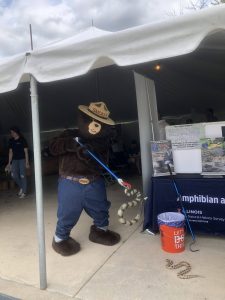
Members of the PaCE Lab exhibited in Conservation World at the 2019 Illinois State Fair, providing information and education to over 500 visitors. In addition to displays about the research being done by the group, visitors were able to try their hand at using actual field equipment used by scientists in their daily work.
The Illinois Bat Conservation Program had a mist net deployed where visitors could untangle, identify, and measure bats, all while wearing leather gloves.
The Amphibian and Reptile Conservation group had snake tongs, hooks, calipers, and radio telemetry equipment available for visitors to try to wrangle snakes into a snake bag, measure turtles, or track a hidden turtle.
Other activities included Build-a-Bug, where people can assemble the arthropod of their dreams (or nightmares) from a variety of general and specialized appendages, Wheel of Migration, about the risks migratory birds face, and locating PIT-tagged animals.

UBAP Malacologists Sarah Douglass and Jeremy Tiemann wrote an article for the Fall 2018 issue of Illinois Audubon: “The Enigmatic Asian Clam.” Asian Clams are an invasive species that became established in the Midwest in the 1960s. Douglass and Tiemann identified an unknown species of Asian Clam found in the Illinois River in 2015 and have been studying its distribution. They plan to examine the effect of Asian Clams on the growth of native mussels in Illinois streams.
UBAP Malacologists Sarah Douglass and Jeremy Tiemann wrote an article for the Fall 2018 issue of Illinois Audubon: “The Enigmatic Asian Clam.” Asian Clams are an invasive species that became established in the Midwest in the 1960s. Douglass and Tiemann identified an unknown species of Asian Clam found in the Illinois River in 2015 and have been studying its distribution. They plan to examine the effect of Asian Clams on the growth of native mussels in Illinois streams.
The article is available from Illinois Audubon or by contacting the authors.
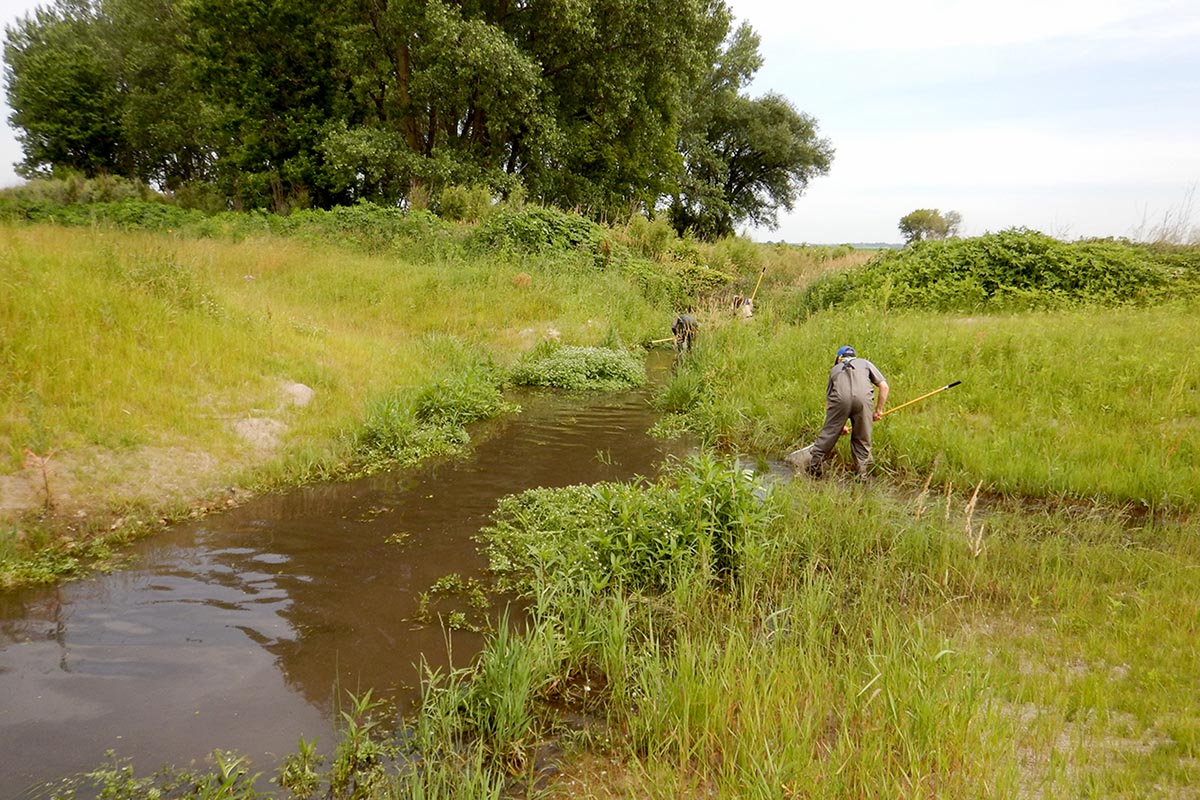 UBAP Ichthyologist Andrew Stites wrote a field account for the Illinois News Bureau’s Behind the Scenes to accompany a recent paper by Josh Sherwood, Andrew Stites, Michael Dreslik, and Jeremy Tiemann.
UBAP Ichthyologist Andrew Stites wrote a field account for the Illinois News Bureau’s Behind the Scenes to accompany a recent paper by Josh Sherwood, Andrew Stites, Michael Dreslik, and Jeremy Tiemann.
The paper, “Predicting the range of a regionally threatened, benthic fish using species distribution models and field surveys” developed a species distribution model for the state endangered Iowa Darter, after finding it in several new locations. This work was sponsored by the Illinois Tollway.
Read the Behind the Scenes: Finding darters where no one thought to look
Read the paper in The Journal of Fish Biology
The Hine’s Emerald Dragonfly (Somatochlora hineana), a dark bodied dragonfly with bright green eyes, is a federally endangered species that lives in spring fed marshes and sedge meadows. The biggest threat to the species is habitat loss and currently the only known populations are in Illinois, Michigan, Missouri, and Wisconsin.
Hine’s Emerald Dragonflies spend most of their life as an aquatic nymph. After 2-4 years, and several molts, the nymph climbs up onto vegetation and molts one final time. The wings unfold and the soft body hardens. While some dragonfly species can be found flying throughout the summer and into the fall, the Hine’s flight season is much shorter. Adults emerge from late June through mid-July.

One bright and sunny day at the end of June, I was able to accompany 2 of the state’s top dragonfly experts, Richard Day and Jim Wiker to one of the few remaining populations in Illinois. Equipped with sharp eyes and binoculars, they are part of a study with Erika Bilger and Dr. Mike Dreslik to design a non-invasive, rapid survey protocol for documenting and tracking populations of this endangered insect.
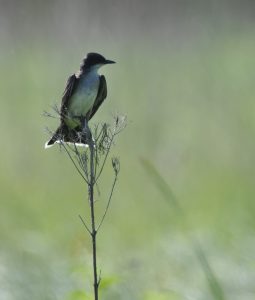
As the day warmed, dragonflies took flight, often followed by a flock of swallows and kingbirds. Being a rusty amateur dragonfly enthusiast, I pointed out the dragonflies I saw flying and had the professionals identify them, excited at how often my silent identification matched theirs. As my confidence grew, I’d point to a dragonfly and offer a hesitant ID.

A few hours into the day, Wiker spotted a black bodied dragonfly with bright green eyes darting around the wetland and called out “Hine’s!” All eyes turned to where he was pointing. This was my first time seeing a Hine’s Emerald and Day’s first time seeing one in Illinois. Truth be told, I had to trust them because it was moving too fast for me to fully process.
We continued our surveys throughout the afternoon, with Wiker and Day spotting additional Hine’s Emeralds and my eyes and camera missing all of them. Even though we saw at least 14 species of dragonfly, I returned home slightly disappointed, but nothing compared to the next day.
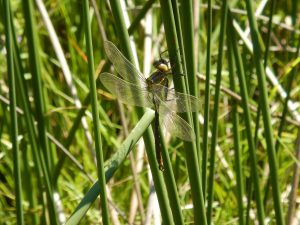
Sitting in my office, the phone rang and Mike Dreslik excitedly told me they were looking at a teneral (freshly emerged, not yet hardened) Hine’s Emerald on a cattail! Dragonflies can’t fly until their wings harden, so they were able to stand back and admire this individual.
Determined to actually see a Hine’s, I returned to the site with them for three days the following week. While most people were enjoying barbecues and fireworks, I was in a wet prairie straining to see every insect zipping by me. On my last day, with temperatures in the 90’s, and the clouds promised by the weatherman non-existent, I thought I might have been hallucinating when Wiker began excitedly pointing out a Hine’s patrolling a small area in front of me.
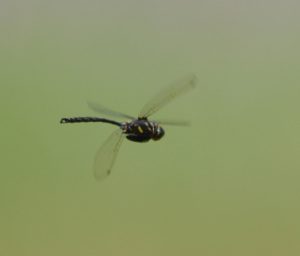 The curious male flew back and forth over his territory, occasionally turning towards me with his bright green eyes. Dragonflies have greater maneuvering ability than a helicopter, quickly changing direction and zipping off to your right only to return from your left. I watched this dragonfly on patrol, he chased off other intruding dragonflies including another Hine’s emerald! We even had a Hine’s Emerald female fly through the site! I continued to watch the male patrol until it was time to move to our next site.
The curious male flew back and forth over his territory, occasionally turning towards me with his bright green eyes. Dragonflies have greater maneuvering ability than a helicopter, quickly changing direction and zipping off to your right only to return from your left. I watched this dragonfly on patrol, he chased off other intruding dragonflies including another Hine’s emerald! We even had a Hine’s Emerald female fly through the site! I continued to watch the male patrol until it was time to move to our next site.
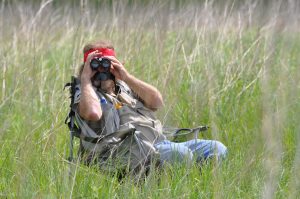
The team completed 126 surveys for Hine’s Emerald Dragonflies over a three week period. Sadly, they only found Hine’s during approximately 19 surveys and many of those surveys had only one individual. Despite the low abundance of Hine’s Emeralds, the site still had a variety of dragonflies, including:
While conducting surveys today in DuPage County, INHS entomologist Jason Robinson and his assistant Maria Repisak came across Rusty Patched Bumblebees at two sites! This species was recently added to the US Endangered Species List because of its drastic decline across its range.
For more information on the Rusty Patched Bumblebee, visit the USFWS website
Photo by Maria Repisak
By Devin Edmonds
Historically the Ornate Box Turtle was known from 45 counties in Illinois. Today you can count the number of counties with confirmed populations on two hands. This decline landed the species on the List of Endangered and Threatened Species of Illinois in 2009, with habitat loss and road mortality being the greatest threats to its continued survival.
We had the opportunity to survey two of the largest known Ornate Box Turtle sites this past week, with the goal of finding, measuring, and marking as many turtles as possible. With enough recaptures, we can calculate how likely it is for an individual to survive from one year to the next and determine population size. This helps us answer questions including: has population size changed over time? Is the population stable, increasing, or decreasing? Is the population at risk of extinction?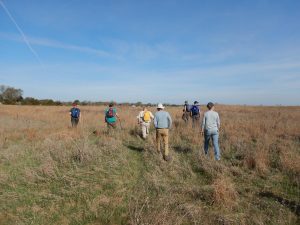
Searching for reptiles and amphibians is often quite tedious. You have to carefully scan ahead of each step for movement before a snake gets away, or spend hours flipping over logs to find the particular salamander you are looking for.
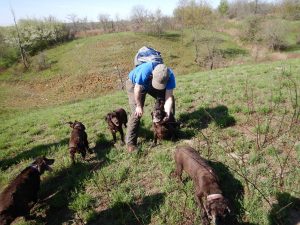 Fortunately, we were assisted on our survey by John Rucker and his Boykin Spaniels, who are not pets but rather working dogs. Years ago one dog proudly brought John Rucker a box turtle it turned up in the woods of Tennessee. He praised the dog and soon it brought back another one in its mouth. Eventually he turned his group of turtle finding dogs into a profession, helping biologists find these once common but increasingly rare chelonians for study.
Fortunately, we were assisted on our survey by John Rucker and his Boykin Spaniels, who are not pets but rather working dogs. Years ago one dog proudly brought John Rucker a box turtle it turned up in the woods of Tennessee. He praised the dog and soon it brought back another one in its mouth. Eventually he turned his group of turtle finding dogs into a profession, helping biologists find these once common but increasingly rare chelonians for study.
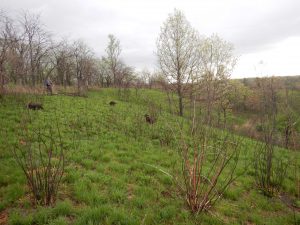 With John’s dogs, our work was made easy. They carried on ahead of us, their noses to the ground, brown bodies nearly concealed by knee-high grass. When a turtle was found, a dog picked it up in its mouth and carried the reptile like a precious toy, walking to John with pride and eyeing anyone else who offered to take the turtle from it with suspicion. John praised the dog and then gave the turtle to one of us to to be worked up.
With John’s dogs, our work was made easy. They carried on ahead of us, their noses to the ground, brown bodies nearly concealed by knee-high grass. When a turtle was found, a dog picked it up in its mouth and carried the reptile like a precious toy, walking to John with pride and eyeing anyone else who offered to take the turtle from it with suspicion. John praised the dog and then gave the turtle to one of us to to be worked up.
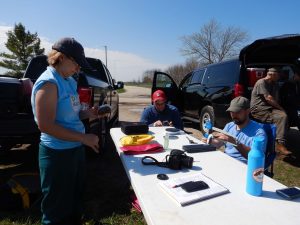 To keep track of individual turtles we are catching and whether they survive from one year to the next we mark each turtle with a code. The process is called shell notching, and involves cutting little pieces out of the marginal scutes (the sections of shell that border the outer edge) to assign a unique identification code to each individual turtle. The scutes are numbered from one to twelve on left and right sides, and by notching different combinations of scutes on each side more than 30,000 individuals can be individually identified. For example, by cutting a little section of shell on the first scute on the left side and the third scute on the right, you have just identified an individual as 01L-03R. When done properly, the shell notches stay with the turtle for the rest of its life.
To keep track of individual turtles we are catching and whether they survive from one year to the next we mark each turtle with a code. The process is called shell notching, and involves cutting little pieces out of the marginal scutes (the sections of shell that border the outer edge) to assign a unique identification code to each individual turtle. The scutes are numbered from one to twelve on left and right sides, and by notching different combinations of scutes on each side more than 30,000 individuals can be individually identified. For example, by cutting a little section of shell on the first scute on the left side and the third scute on the right, you have just identified an individual as 01L-03R. When done properly, the shell notches stay with the turtle for the rest of its life.
Mortality events due to disease outbreaks have been documented in the closely related Eastern Box Turtle, and there is concern that the Ornate Box Turtle is also at risk. While we were marking and measuring turtles, Dr. Matt Allender and members of the Wildlife Epidemiology Lab were giving each turtle a physical exam, drawing blood, and swabbing their mouth and cloaca to screen for diseases and monitor health. Their work is providing a baseline for future studies on the health of box turtle populations.
With the help of the turtle dogs, we found more than one hundred turtles at the first site and nearly seventy at the second. The data is now awaiting entry and analysis, but several turtles we found were originally marked by the Illinois Department of Natural Resources in 1988. At more than 30 years of age, these individuals are approaching the maximum known lifespan for the species.
Together with the population health assessment, we expect our ongoing project will guide conservation efforts for the Ornate Box Turtle in Illinois and help ensure its continued survival.
Mussels are often referred to as “the livers of the rivers” because they filter materials from their environment. Freshwater mussels are also among the most imperiled groups of organisms in the world.
We arrived at the site around 8:30 and began unloading and setting up all of the gear needed for the day. A group of 20 biologists and land managers eagerly grabbed sampling bags, donned wetsuits, waders, snorkels and masks and each claimed their 10m stretch of the river.
When given the signal, we plunged our heads into the swift moving, 70F water to begin locating every mussel we could in our stretches of river and placing them in mesh bags attached to our waists. Much musseling is done by grubbing – shoving ones hands into the sediment and feeling around for mussels, which feel a bit like smooth rocks that hold on in the gravel with a fleshy foot. For some in the group, this was their first time musseling, and finding their first mussels was exhilarating.
After 30 minutes of sampling, we brought our bags of mussels back to the base station. Here, under the bridge with its constant rumble of vehicles speeding by, numbered tags were glued to each mussel. Some of the mussels also had a Passive Integrated Transponder (PIT) tag glued to their shell, which will enable them to be detected in the future without being removed from the river. Malacologists identified, measured, sexed, and aged each mussel before putting it back in its bag to be returned to its place in the river.
We continued these sampling sessions until the entire project area had been sampled. Over the lifetime of this project, thousands of mussels will be marked and measured. Many of the mussels we encountered had been marked in previous years, which will enable the scientists to document growth and survival over time as well as movement within the river.
As we left the site on the last day, we all looked forward to returning next year and hopefully finding those mussels and many new ones.